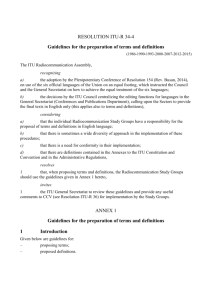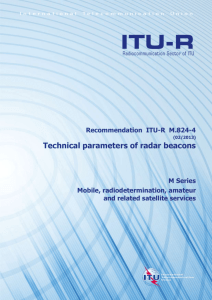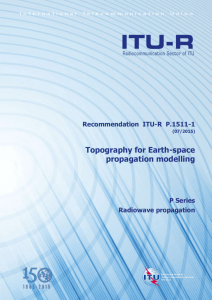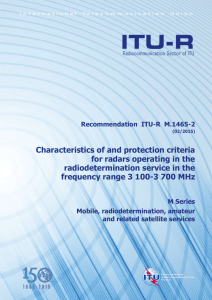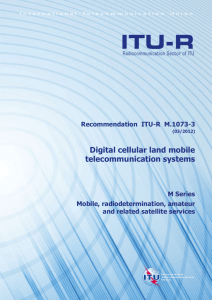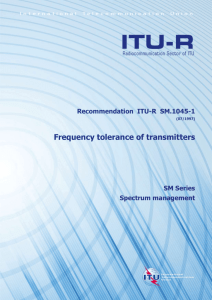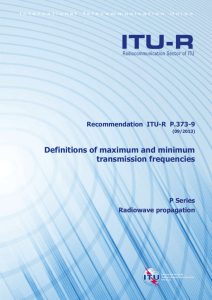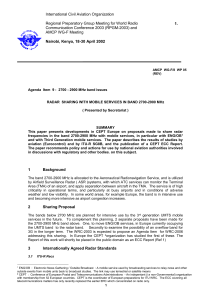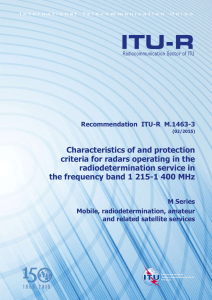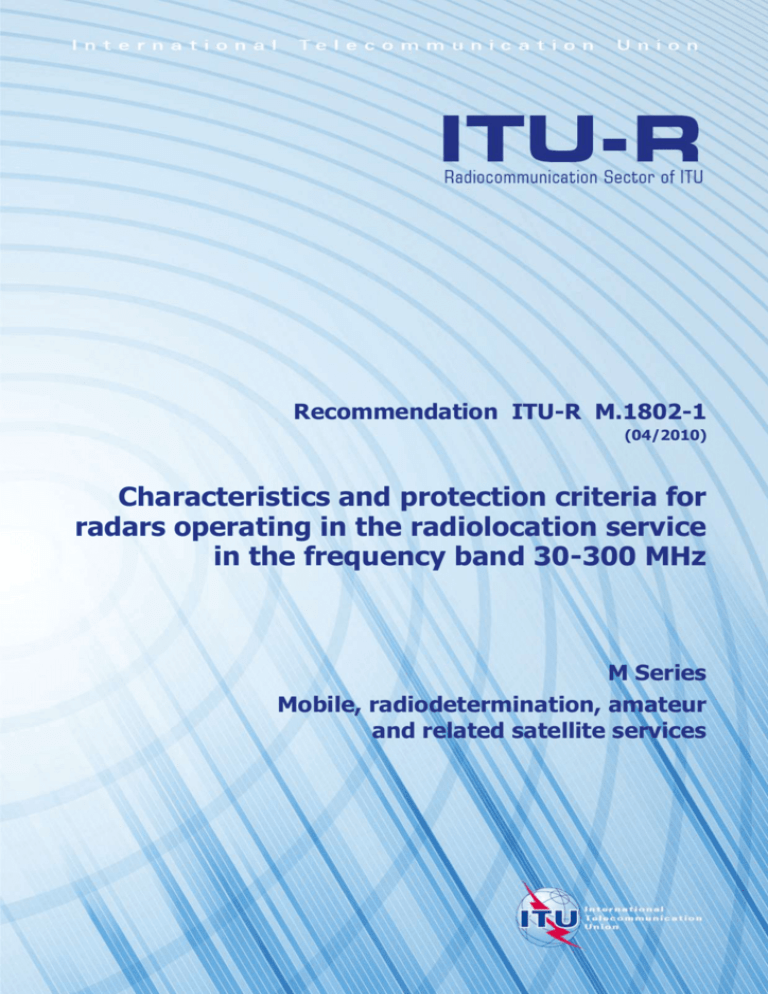
Recommendation ITU-R M.1802-1
(04/2010)
Characteristics and protection criteria for
radars operating in the radiolocation service
in the frequency band 30-300 MHz
M Series
Mobile, radiodetermination, amateur
and related satellite services
ii
Rec. ITU-R M.1802-1
Foreword
The role of the Radiocommunication Sector is to ensure the rational, equitable, efficient and economical use of the
radio-frequency spectrum by all radiocommunication services, including satellite services, and carry out studies without
limit of frequency range on the basis of which Recommendations are adopted.
The regulatory and policy functions of the Radiocommunication Sector are performed by World and Regional
Radiocommunication Conferences and Radiocommunication Assemblies supported by Study Groups.
Policy on Intellectual Property Right (IPR)
ITU-R policy on IPR is described in the Common Patent Policy for ITU-T/ITU-R/ISO/IEC referenced in Annex 1 of
Resolution ITU-R 1. Forms to be used for the submission of patent statements and licensing declarations by patent
holders are available from http://www.itu.int/ITU-R/go/patents/en where the Guidelines for Implementation of the
Common Patent Policy for ITU-T/ITU-R/ISO/IEC and the ITU-R patent information database can also be found.
Series of ITU-R Recommendations
(Also available online at http://www.itu.int/publ/R-REC/en)
Series
BO
BR
BS
BT
F
M
P
RA
RS
S
SA
SF
SM
SNG
TF
V
Title
Satellite delivery
Recording for production, archival and play-out; film for television
Broadcasting service (sound)
Broadcasting service (television)
Fixed service
Mobile, radiodetermination, amateur and related satellite services
Radiowave propagation
Radio astronomy
Remote sensing systems
Fixed-satellite service
Space applications and meteorology
Frequency sharing and coordination between fixed-satellite and fixed service systems
Spectrum management
Satellite news gathering
Time signals and frequency standards emissions
Vocabulary and related subjects
Note: This ITU-R Recommendation was approved in English under the procedure detailed in Resolution ITU-R 1.
Electronic Publication
Geneva, 2010
ITU 2010
All rights reserved. No part of this publication may be reproduced, by any means whatsoever, without written permission of ITU.
Rec. ITU-R M.1802-1
1
RECOMMENDATION ITU-R M.1802-1
Characteristics and protection criteria for radars operating in the
radiolocation service in the frequency band 30-300 MHz
(Question ITU-R 237/5)
(2007-2010)
Scope
This Recommendation describes VHF radiodetermination radars and provides technical parameters and
protection criteria for some type of radars operating in the band 30-300 MHz.
The ITU Radiocommunication Assembly,
considering
a)
that technical characteristics of radars operating in the radiodetermination service depend
on specific applications, and could significantly vary, even within the same frequency band;
b)
that within different ITU Regions as well as in different countries certain frequency bands
in the range 30-300 MHz are allocated to the radiodetermination service;
c)
that the VHF range provides unique capabilities for detecting objects at a very large
distance, that is the most suitable for tracking and identification of space objects;
d)
that analysis of frequency sharing between radiodetermination radars and systems in other
services and determination of the feasibility of implementing new types of radiodetermination
radars and to select appropriate frequency bands require knowledge of technical and operational
characteristics of the systems operating in a specific frequency band,
recommends
1
that technical and operational characteristics and protection criteria of the radiolocation
radars described in Annex 1 should be considered representative of those systems operating in the
frequency range 30-300 MHz and used in studies of compatibility with systems in other services;
2
that Recommendation ITU-R M.1461 should be used as a guideline in analysing
compatibility between radars operating in the radiodetermination service with systems in other
services.
Annex 1
Technical and operational characteristics and protection criteria
of radar systems operating in the frequency range 30-300 MHz
1
Introduction
Representative characteristics of radiolocation radars operating in the frequency range 30-300 MHz
are shown in Table 1. This information is required for assessment of compatibility between radars
and systems in other services.
2
2
Rec. ITU-R M.1802-1
Technical characteristics
The frequency range 30-300 MHz is used by several different types of radars on fixed platforms
within different ITU Regions as well as in different countries. Radiolocation functions performed in
the band are space object recognition and tracing.
TABLE 1
Characteristics of radars operating in the frequency range 30-300 MHz
Parameter
Value
Radar А
Radar type
Radar purpose
Radar В
Primary ranging radar
Radar C
Primary ranging
radar (bi-static)
Space object recognition and tracing
Frequency band (MHz)
154-156
142-144
Relative frequency instability
10–11
10–11
N/A
Output pulse power (min/max) (dBW)
27/46
40/46
47.2
Mean output power (min/max) (dBW)
22/41
35/41
47.2
Polarization
Pulse duration (s)
Linear
13 000
3 200
N/A
Duty cycle
0.322
N/A
Modulation type
Pulse
Continuous Wave
19
5
Altitude above the ground level (m)
Antenna type
Phased array
Maximum antenna gain (dB)
– transmitter
– receiver
25
30
24
N/A
Maximum antenna gain on the horizon (dB)
9
12
Main beam pattern (degrees)
– horizontal plane (Rx/Tx)
– vertical plane (Rx/Tx)
2.6/5.2
2.6/2.6
8
20
Scan angle ranges (degrees):
– horizontal plane
– vertical plane
0-360
2-70
4 sectors
covering:
0-180
30
800
N/A
Receiver noise temperature (K)
Operational receiver passband (kHz)
0.132
625
50
Necessary bandwidth (kHz)
0.132
625
<1
Emission class
P0N
MXN
N0N
I/N protection ratio (dB)
NOTE 1 – N/A – not applicable.
−6

